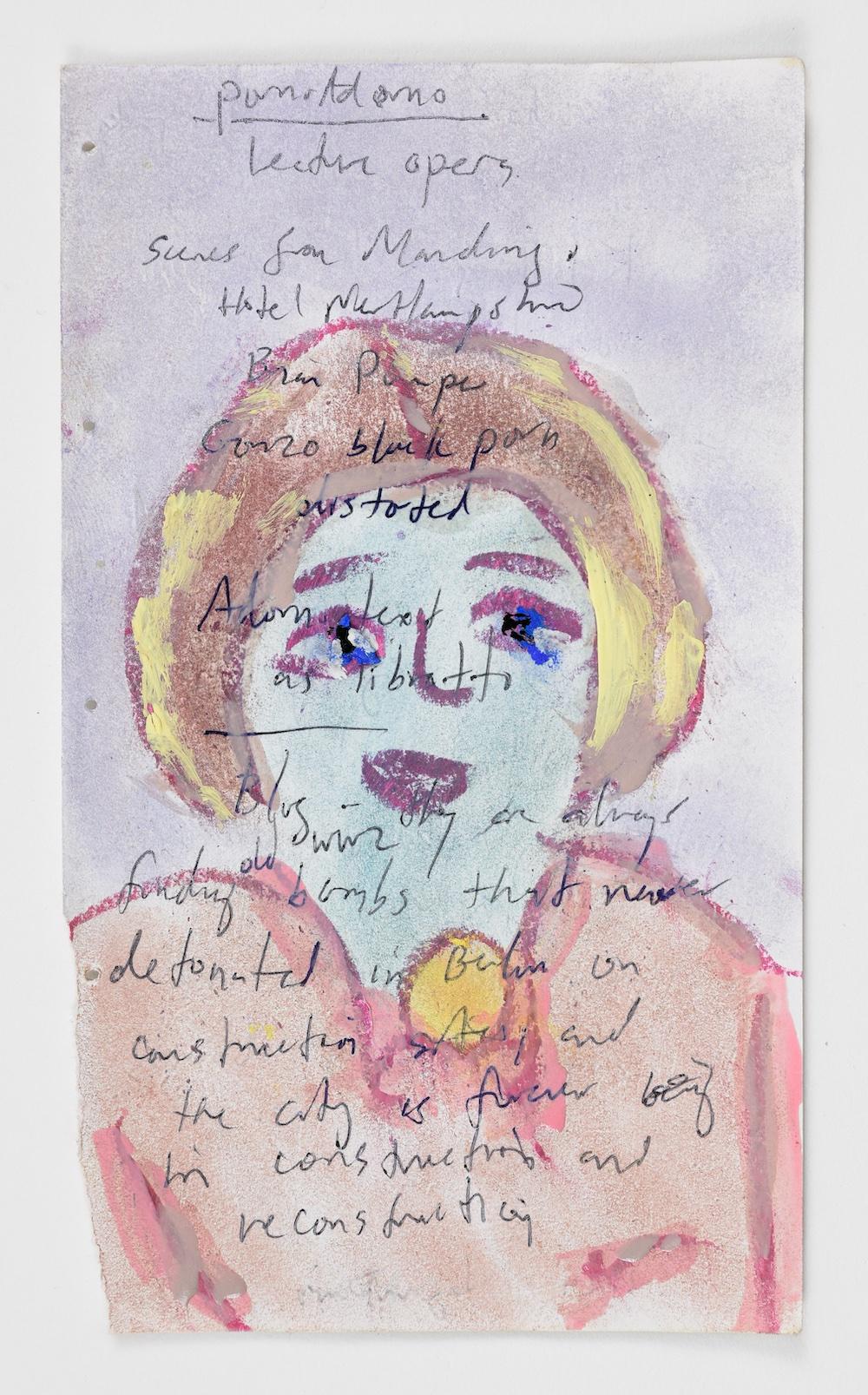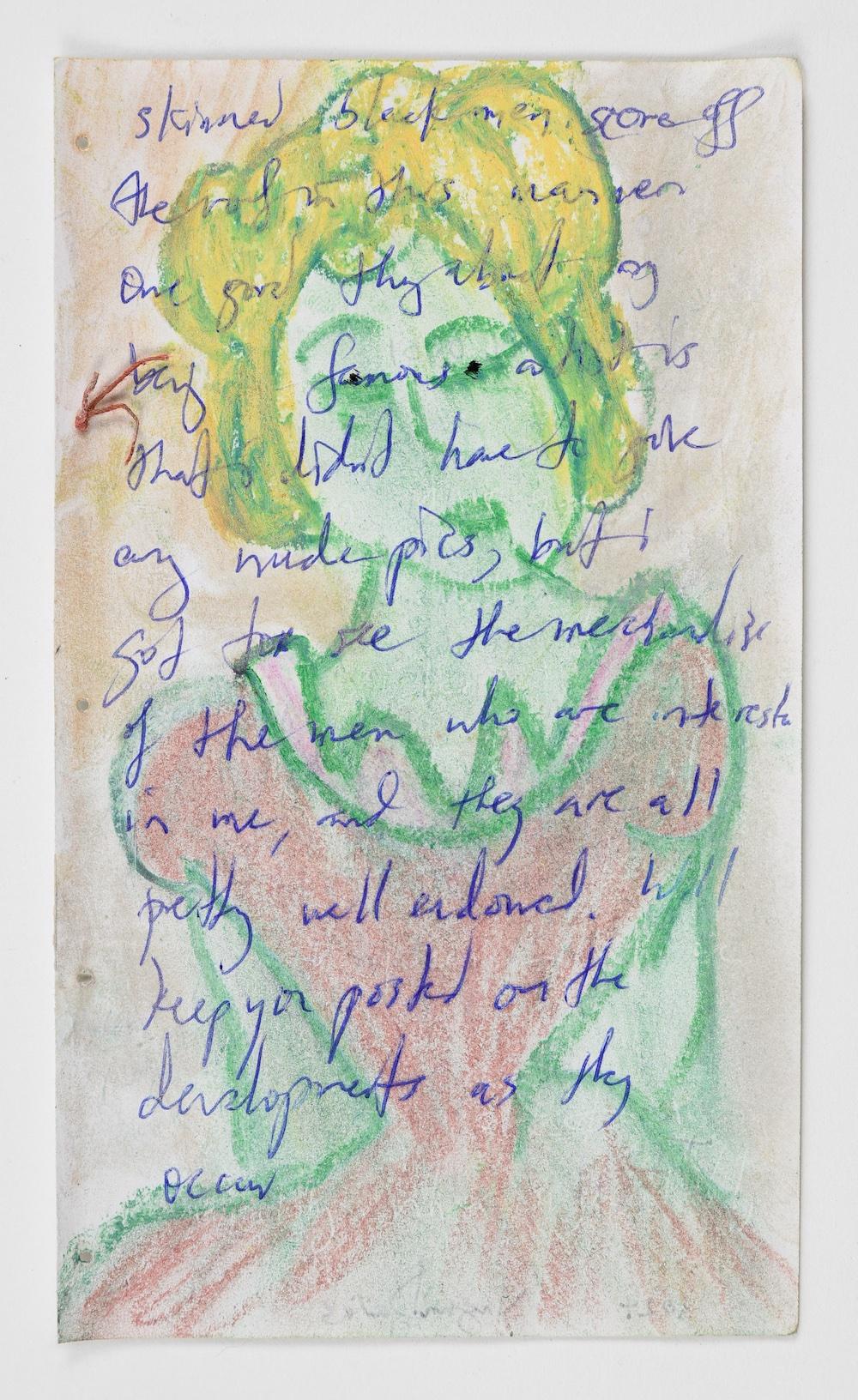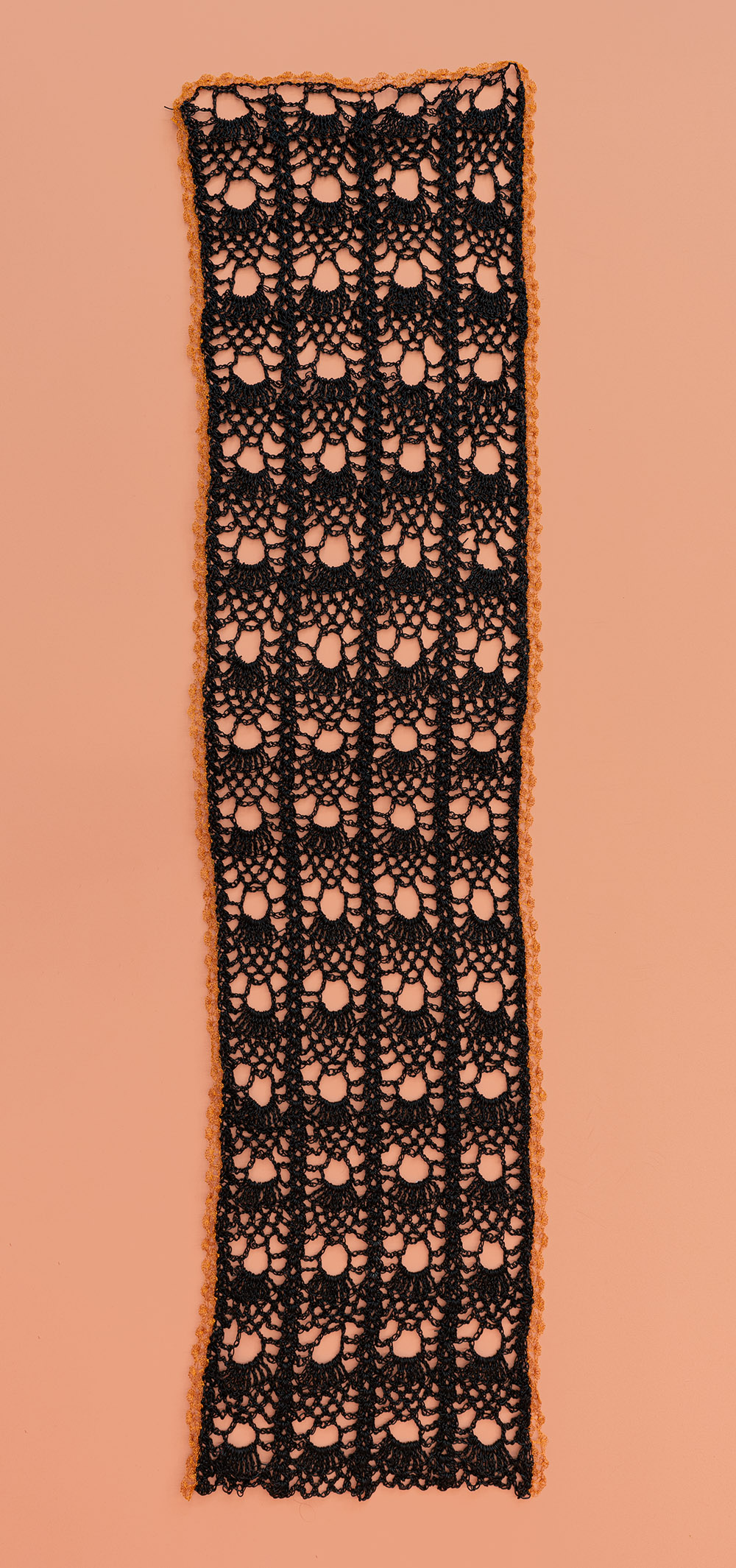“Pray for us sinners, now and at the hour of our death: Vaginal Davis and ektor garcia at Adams Ollman”
by Andrew Suggs, October 2024.
Blog: They are always finding old
WW2 bombs that never detonated
in Berlin on construction sites, and
the city is forever in construction
and reconstruction.
This note appears in Vaginal Davis’ handwriting in blue ink underneath one of her small portrait-drawings made with cheap makeup on view in There’s Something About Maria at Adams Ollman in Portland, Oregon. This quiet but profound show intersperses this recent suite of drawings of various contemporary and historical Marys, Marias, and Mariannes amidst a mise-en-scene of witchy mood created by the labor intensive work of another “brown queer punk,” ektor garcia, whose practice draws upon craft and artisan traditions of his ancestral Mexico. Vaginal and ektor are friends and both expats; Vaginal left her native LA for Berlin years ago, and ektor relocated to Mexico City as an adult from north of Sacramento where he grew up. They have both experienced a sense of not-belonging, an all-too-familiar feeling for most queers.

Vaginal Davis
Maria Montessori, 2024
Schminkstifte, Jofrika Cosmetics, eyeshadow palette de Fard à paupières, Colormates Eyeshadow, Wet n Wild Color Icon palette de 10 Teintes, San Soucis Eyeshadow, Harley Quinn Essence Eyeshadow, lip liner, eyebrow pencil, hydrogen peroxide, glycerine, Santee Gel Nail Varnish, and Aqua Net Hairspray on found paper
6 11/16h x 3 15/16w in
16.99h x 10w cm
VD2024006
On that same portrait (this one is of Maria Montessori—a woman who went to engineering school with all men and later created a visionary and decidedly anti-patriarchal education model)—are Ms. Davis' other notes which are sometimes simply phone numbers or lists and other times read as quotidian poetry or richly layered brainstorms. The texts that run under, through, and become implicated in the portraiture suggest the contents of an artist’s notebook, repurposed, but the juxtapositions and layered meanings are by turn complex, irreverent, funny, or speak to repetitive cycles of everyday life.
One mentions an Adorno lecture on opera. Another reads “scenes from The Hotel New Hampshire and Mandingo.” There are also mentions of video cues and arias. These give the idea that Davis may be gearing up for an operatic project of her own, or thinking of it. The generously shared process notes and intimate details in text add a layer to the portraits, which are as much a portrait of Davis and her relationship to the subjects as they are a chronicle of and celebration of female power.
In a couple cases the found paper has a text of its own (found text, not Davis’ handwriting), which Davis folds equally effectively into these miniature but sophisticated palimpsests. For instance, Mary Ellen Pleasant’s picture is marked with the word “CHEAP,” where the C is formed by a sickle and hammer and appears to have been stamped on the paper before her use of it. Marianne Williamson’s picture is drawn over a takeaway from the Rotterdam Film Festival and contains contact information for Paige Sarlin, the director of a 2017 documentary about Kodak’s discontinuation of the carousel slide projector. No careless coincidences here.
A portrait of Archduchess Maria Theresa of Austria (the only woman leader of the Holy Roman Empire, who is lauded more than most all her male counterparts) is drawn over a diary entry made partly illegible by the makeup smears that constitute the figure:
...one good thing about being a
famous artist is that I didn’t have to
send any nude pics, but I get to see
the merchandise of the men who
are interested in me, and they are
all pretty well endowed. Will keep
you posted on the developments as
they occur.

Vaginal Davis
Archduchess Maria Theresa of Austria, 2024
Schminkstifte, Jofrika Cosmetics, eyeshadow palette de Fard à paupières, Colormates Eyeshadow, Wet n Wild Color Icon palette de 10 Teintes, San Soucis Eyeshadow, Harley Quinn Essence Eyeshadow, lip liner, eyebrow pencil, hydrogen peroxide, glycerine, Santee Gel Nail Varnish, and Aqua Net Hairspray on found paper
6 11/16h x 3 15/16w in
16.99h x 10w cm
VD2024022
This reads like a letter but seems to be the original. Did Davis draft this here then type off a letter or email to her friend? Is it the record of an email already sent, repurposed as text for this piece specifically? Was the letter discarded before it was passed along to the intended recipient?The temporal confusion hinted at here—a queer back-and-forth between history and the recent past—permeates the exhibition.
There’s Something About Maria includes 26 of Davis’ tarot card-sized drawings, including one presented in the back room, in a chapel-like display, of Marie (née Maria) Salomea Sklodowska-Curie (often cited as simply Marie Curie), in a custom crocheted frame and accouterments by garcia. Vaginal’s own mother, not pictured in this show but atmospherically invoked, was named Mary Magdalene Duplantier.

ektor garcia
portal LES, 2023
crochet leather, raw copper, and copper wire
86h x 18w in
218.44h x 45.72w cm
egarcia 06
The exhibition features new sculpture by ektor garcia, crocheted works in copper, leather and wool; ceramic vessels; and cast bronze. The gallery reads more like a personal devotional space than a commercial white cube; the walls have been painted a pinkish terra cotta; garcia has lined the perimeter of the floor with lavender; and devotional candles etched with designs from them both burn scattered through the space. A bouquet of red cockscomb (changed by the gallery staff periodically to remain in bloom) sits in one of his ceramic vessels and rests atop a copper doily. garcia’s delicate and tough crocheted pieces hang from the ceiling. All of his work has a domestic feel; here, his work is what transforms the gallery into a warm and intimate space.
garcia’s work stunningly inverts material norms. He often crochets with black leather and raw copper in place of fibers, alluding to the conductive properties of the metal and to gay leather culture. Or what appears to be a bundle of twisted fibers is actually crafted from porcelain. With this reversal of the expected, he highlights the delicacy of balance within the world more generally as he seamlessly weaves together queer and Mexican ancestral practices. This subtle but important attention to materiality is akin to Davis’ use of found art world garbage. Both the artists are turning to the humble, the overlooked or undervalued. The materials they gather and glean come from and speak to their ongoing, everyday methods of survival.
garcia’s pieces are more fragile, more involved, sexier than they seem at first glance. They all bear an undeniable relation to ektor’s own body, which makes perfect sense given that he is often carrying around his crochet implements in a bag, making as he goes. These craft techniques are not ones he grew up learning from immediate family, but he has returned to through a practice of revisitation and honor of his ancestors (particularly the female ones, practitioners of fiber arts to whom the vessels allude). There are forms decidedly his, though, like the spiderwebs that appear here as elsewhere in his practice. The webs are part of a queer witchy aesthetic that speaks to created community; the dusty backrooms of forgotten or trodden-over histories; and of course the miraculous beauty of a spinning spider’s life: her perfectly imperfect geometry (and majestic danger). There is a circularity to his work that crochet practitioners will know is intrinsic to the art, from repeated forms to the importance of the necessarily round needle’s diameter. His use of copper doilies in this show is particularly joyful. During the Victorian era, doilies served a purpose: to protect soft furniture from the pomade men used in their hair, their stains and sweat. These protective doilies were called macassars, a word I learned from ektor. Macassar also refers to the cloth flap on a sailors’ tops, which was designed in part to keep Macassar oil (an early 19th-century pomade) off their uniforms.

ektor garcia
arde que arde, 2024
glazed ceramic, crochet copper wire
12 1/4h x 10w x 10d in
31.12h x 25.40w x 25.40d cm
egarcia 09
A remarkably immense span of history is represented or referenced in this small show: from the pillaging of metal from indigenous cultures, to the bold woman who helped normalize female erotic desire through autobiography (Mary Mac Lane), to nostalgia around 1990s Wet N’ Wild nail polish, to philosophy on opera and contemporary film theory. José Esteban Muñoz wrote about Davis’ “terrorist drag” nearly 25 years ago as he was formulating his now ubiquitous theories around queer futurity. In his beautiful and hopeful reckoning, queer artists look to the past to imagine a future. On the cover of his book Disidentifications, a younger Vaginal Davis sits looking askance, refusing direct contact with the gaze of the camera or its photographer. The chapter on her work in the book is titled “The White to Be Angry.” Likewise, and much more recently, the title of the show where garcia’s work got widespread attention, “Trigger: Gender as a Tool and a Weapon” (curated by Johanna Burton at the New Museum in 2017) also seems too confrontational, too militarized, angrier than what is shown here. If this pair weaponizes anything, it may be quite solitary prayer, cheap but beloved gaudy makeup palettes, a look into the deep annals of history lest we forget our ancestors, or joy found in the personal everyday iterations and patterns of our lives—the turning of small pages, the making of the next crochet loop.
Being out of place seems prescient. To not belong to one of two (problematically polarized) extremes means to be out of place, confused, angry, resigned. These artists remind us what it’s like to be in the middle place where we can blur and confuse binaries, look to the cosmos, spirituality, otherworldliness, hidden histories, mother figures.
The personal is political. The private is political. Our histories, our communities, our closets, and the psychic workings of our minds are also political, as we see on display here. In a moment when religious fervor undergirds hateful politics, two queer punks lightly embrace the devotional. As ecological disaster and devastating wars rage around us, perhaps we would all do well to say a Hail Mary and light a candle tonight as Davis and garcia encourage us to mind the buried bombs.
———————————————
Andrew Suggs is a curator, writer, and artist from Appalachian Tennessee who lives and works in New York, NY. His work centers on art and AIDS, queer art and artists, disruptive and alternative strategies, and performance. Suggs holds a BA in art, film, and visual studies from Harvard University and is a master’s candidate at the Center for Curatorial Studies, Bard College.